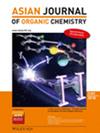Dehydrogenative Coupling Reaction for the Synthesis of 5‐ and 6‐Heterocyclic Derivatives Catalyzed by Earth‐Abundant Metal‐Based Complexes
IF 2.8
4区 化学
Q1 CHEMISTRY, ORGANIC
引用次数: 0
Abstract
Heterocycle synthesis is an intense research area due to their significant importance in pharmaceutical, material chemistry and fine synthesis. Key innovations include transition metal‐based‐catalyzed heterocyclic derivatives synthesis, which facilitates diverse structural modifications, enhances selectivities and efficiency. The necessity to develop more greener technologies for the construction of new C−C and C−N bonds has strived chemists to re‐design their synthetic strategy plan and to introduce abundant starting materials. Among these new transformations, acceptorless dehydrogenative coupling (ADC) reactions have received increased attention thanks to their atom‐economy, the use of alcohols as pro‐electrophiles and the formation of water and hydrogen gas as only by‐products. These methods exemplify the interplay between traditional and cutting‐edge techniques, providing a robust synthetic toolkit to address the growing demand for biologically relevant compounds with tailored functionalities. This review will focus on the acceptorless dehydrogenative coupling methodologies for the synthesis of nitrogen‐containing 5‐ and 6‐membered heterocyclic derivatives (such as pyrroles, pyrimidines, quinazolines, and quinoxalines) in the presence of 3d‐metal complexes. The state of the art of the ADC process underscores the continuous evolution of synthetic strategies and emphases its importance in creating valuable and structurally diverse compounds, ensuring their centrality in both academic and pharmaceutical research.
稀土金属基配合物催化合成5 -和6 -杂环衍生物的脱氢偶联反应
杂环合成由于其在制药、材料化学和精细合成等方面的重要意义而成为一个研究热点。关键的创新包括过渡金属催化的杂环衍生物合成,它促进了不同的结构修饰,提高了选择性和效率。为了开发更环保的技术来构建新的C - C和C - N键,化学家们努力重新设计他们的合成策略计划,并引入丰富的起始材料。在这些新的转化中,无受体脱氢偶联反应(ADC)由于其原子经济性、使用醇作为亲电试剂以及仅作为副产物形成水和氢气而受到越来越多的关注。这些方法体现了传统和尖端技术之间的相互作用,提供了一个强大的合成工具包,以满足对具有定制功能的生物相关化合物日益增长的需求。本文将重点介绍在三维金属配合物存在下,用于合成含氮5元和6元杂环衍生物(如吡咯、嘧啶、喹唑啉和喹恶啉)的无受体脱氢偶联方法。ADC过程的最新技术强调了合成策略的不断发展,并强调了其在创造有价值和结构多样化的化合物方面的重要性,确保了它们在学术和药物研究中的中心地位。
本文章由计算机程序翻译,如有差异,请以英文原文为准。
求助全文
约1分钟内获得全文
求助全文
来源期刊

Asian Journal of Organic Chemistry
CHEMISTRY, ORGANIC-
CiteScore
4.70
自引率
3.70%
发文量
372
期刊介绍:
Organic chemistry is the fundamental science that stands at the heart of chemistry, biology, and materials science. Research in these areas is vigorous and truly international, with three major regions making almost equal contributions: America, Europe and Asia. Asia now has its own top international organic chemistry journal—the Asian Journal of Organic Chemistry (AsianJOC)
The AsianJOC is designed to be a top-ranked international research journal and publishes primary research as well as critical secondary information from authors across the world. The journal covers organic chemistry in its entirety. Authors and readers come from academia, the chemical industry, and government laboratories.
 求助内容:
求助内容: 应助结果提醒方式:
应助结果提醒方式:


